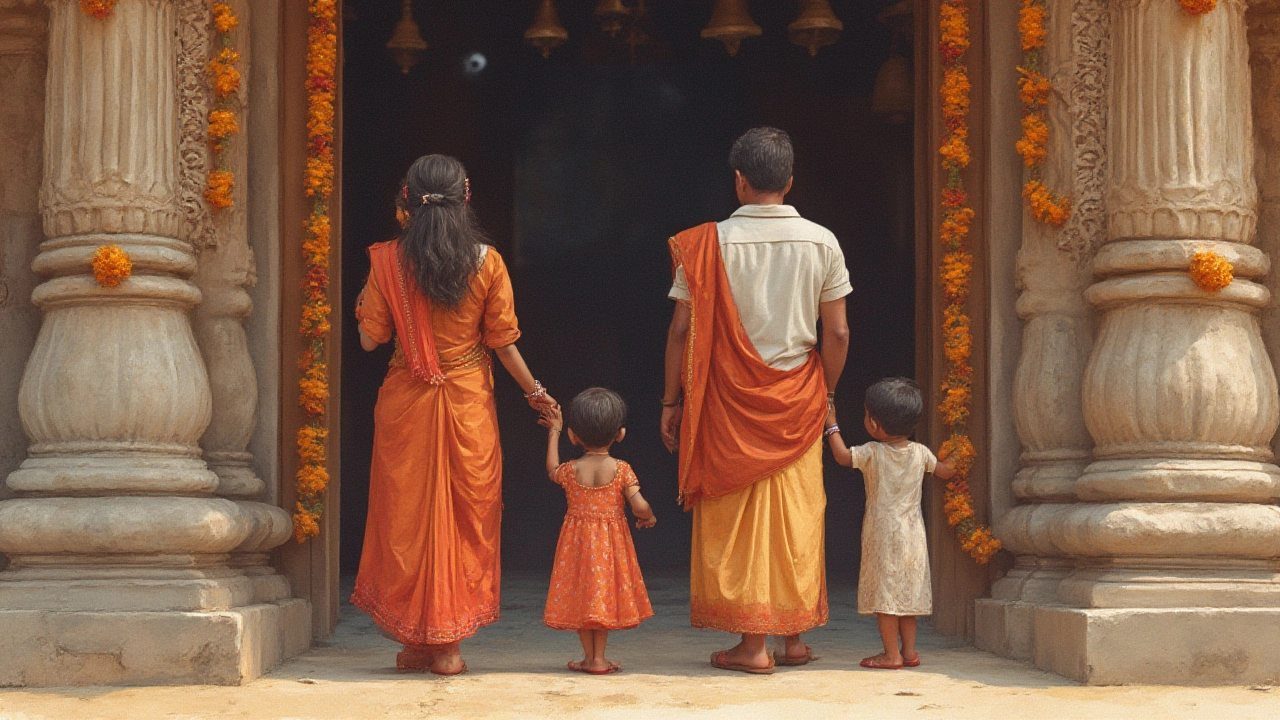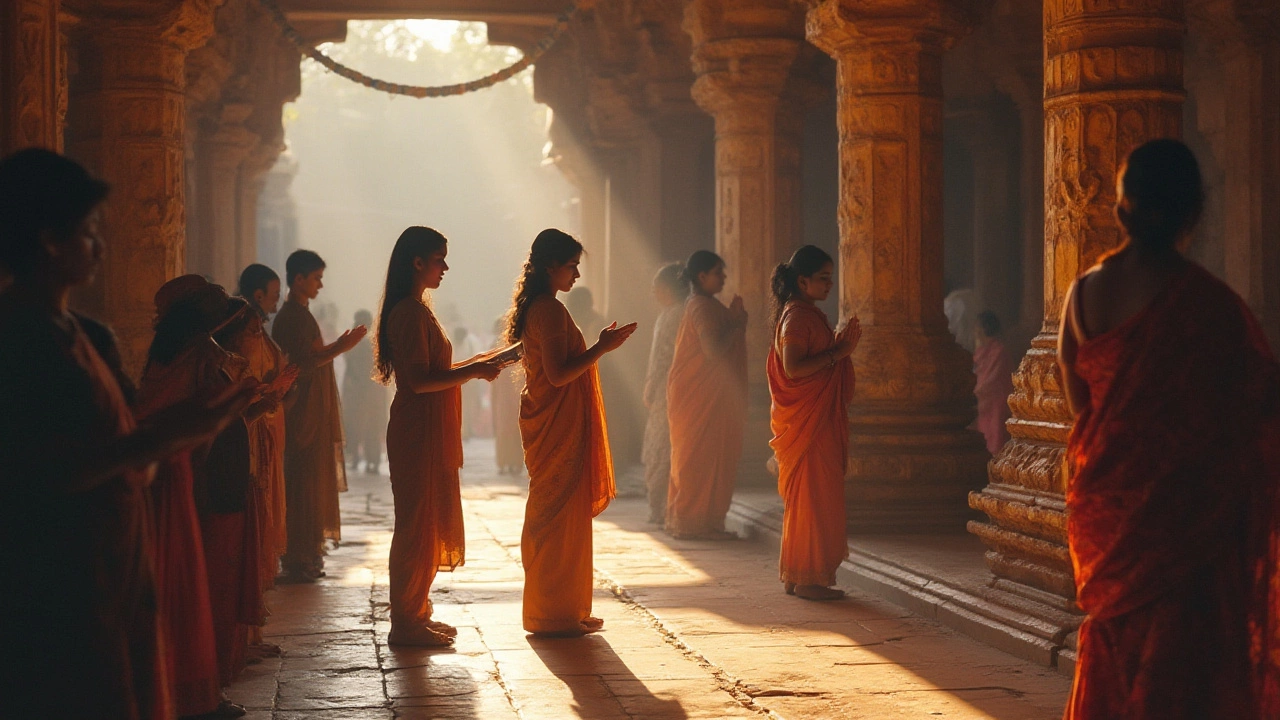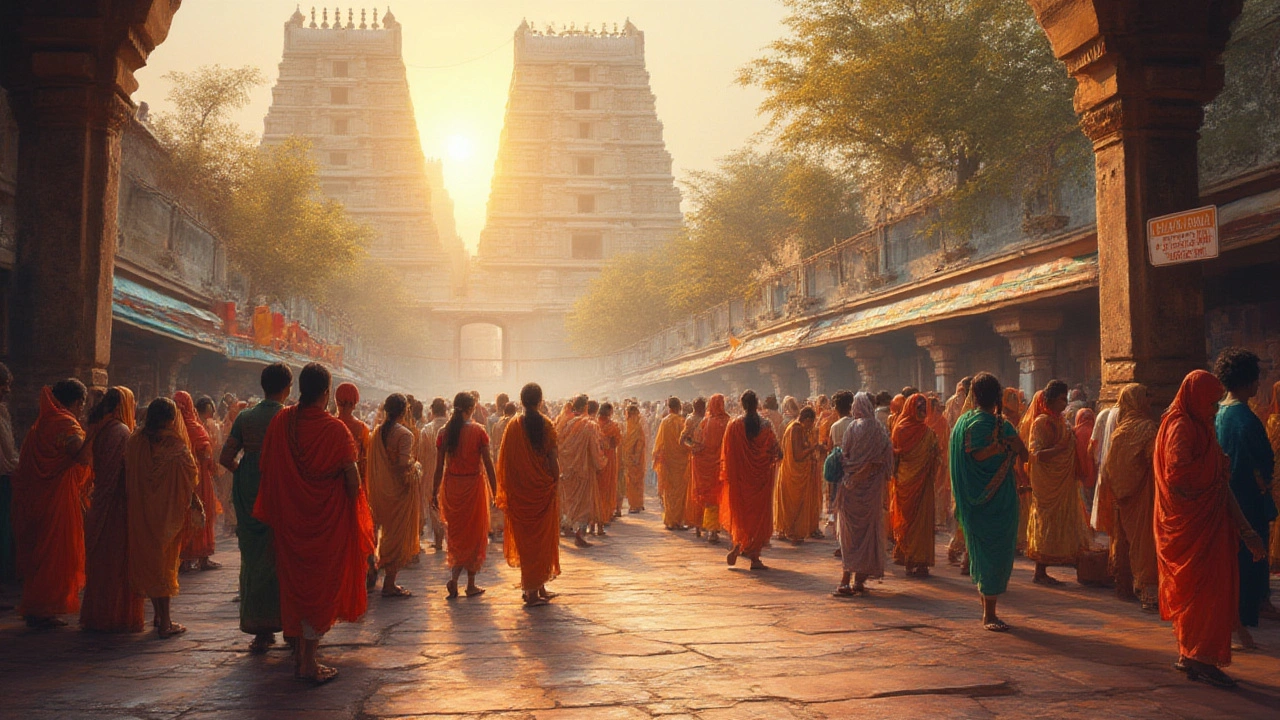Imagine you finally make it to the heart of India’s most vibrant city, drawn by the mesmerizing bells and the sight of a thousand colorful flowers outside a bustling temple. You don’t want to mess this up. You stand with sandals in hand, second-guessing everything. Did you forget a step? Is there something sacred you might miss? Temples in India aren’t just buildings—they’re powerful slices of culture, history, faith, and ritual. Every move matters before you step past that threshold. If you want to experience a temple with real respect and not just as a curious tourist, there’s a whole world of details to consider—even before you get inside.
The Importance of Ritual and Cleanliness
Cleanliness isn’t just about looking tidy when you go to a temple—it’s seen as a spiritual reflection, not just physical. It goes way beyond washing hands—everything from the freshness of your breath to the dust on your feet is up for scrutiny. Indian temples, especially those in the south, operate under strict rules where ritual purity is non-negotiable. For instance, at the Guruvayur Temple in Kerala, not only are leather items forbidden, but even wearing freshly ironed clothes is seen as a sign of respect for the presiding deity. Ever missed brushing your teeth and felt a wave of regret? In some traditions, even a hint of onion, garlic, or meat from your last meal is believed to offend the spirits in the sanctuary.
Let’s talk about feet—one of the biggest unspoken rules in any Indian temple. Shoes are more than just dirty; they carry every bit of street grime and impurity into a holy space. Most temples will have labeled shoe racks or tiny cubby holes at the entrance. People sometimes bring a plastic bag to stash their own, especially in popular shrines where thousands pass through daily and sudden rain showers can mean sticky, muddy floors. Believe it or not, 82% of Indian temples require visitors to remove their shoes, according to a survey by the Indian Ministry of Culture (2023). The logic isn’t just cleanliness (though that’s a bonus)—it’s spiritually symbolic. Feet are considered the lowest, least sacred part of the body, and bringing your shoes in is almost as bad as walking in shouting. Stingy with old socks? Ditch them, or you risk waltzing into the temple with a literal red flag on your soles.
Personal hygiene matters too. Arriving sweaty from a rickshaw ride? Take a moment to wash up in the nearby water taps that many temples provide. It’s not unusual to see locals wash hands, faces, or even swirl water in their mouths. Small things, but they mean you’re not just physically ready—there’s a sense of resetting before entering a sacred space. This cleansing isn’t just “a nice thing to do” either—it’s tied directly to the idea that spiritual experiences demand focus and purity. In some northern rituals, men and women are even asked to avoid consuming non-veg food or alcohol for 24 hours before entering the inner sanctum and festival periods sometimes call for a complete fast. Next time you’re eyeing a street-side snack before temple-hopping, remember this rule. Think of washing up as tuning into the right frequency.
Temple precincts often have designated washing areas, with flowing water and sometimes ash or sandalwood paste for ceremonial purification. These are not random—they’re intentionally placed so each person can mentally mark the transition from regular life to sacred presence. In some iconic temples like the Golden Temple in Amritsar, walking through a shallow pool of water at the entrance is both practical and deeply meaningful. It’s about leaving the dust and drama of the outside behind.
Dress Codes: What to Wear (And What to Avoid)
If you thought choosing an outfit for dinner was tough, try picking one for a temple visit. It’s not about looking fancy—modest, respectful clothing makes all the difference. Think of it less as a fashion rulebook and more as an expression of humility. Traditional attire like kurta-pajamas for men or sarees for women is always safe, but you don’t need to go shopping if you pack smart. Loose-fitting pants and shirts that cover the knees and shoulders often work well, as do long skirts or dresses. Anything with cut-outs, shorts, spaghetti straps, or very tight jeans will give you away as someone who doesn’t get it. Even in the blistering heat, you’ll see locals covered up—partly because in Hindu iconography, the body itself is a vessel to be respected.
Here’s a pro tip: some temples rent or loan out cloth wraps (called "veshtis" or "dhotis") to men and women who aren’t dressed right. I’ve been handed a surprisingly stylish checked wrap at the Meenakshi Temple in Madurai and seen travelers rock makeshift sarees of temple-provided cotton. Especially in the south—Tirupati, Srirangam, and Guruvayur come to mind—men are often asked to remove shirts altogether in the main sanctum, symbolizing equality and humility before the deity. Women may need to cover their heads with a scarf. The logic is simple: if there’s any doubt, choose the option that reveals less skin and keeps the emphasis on reverence, not style.
Color choices matter too. Red, yellow, and white are common in Hindu rituals, but avoid black if you can, as it's associated with mourning in many communities. This isn’t a rule everywhere, but you’ll rarely see huge crowds in black t-shirts at a temple festival. And skip branded prints, sports logos, and especially cartoon characters—nothing says "tourist" louder than that. In places like Sikh gurdwaras, covering your hair is a must for everyone, and there are usually free bandanas at the entrance. Don’t ignore these customs—they’re signs you care about the space you’re in.
Here’s a quick table to make the big do’s and don’ts stick in your mind:
| Item | Permitted? | Notes |
|---|---|---|
| Shorts/Mini-skirts | No | Knees must be covered |
| Tank tops/Sleeveless | No | Cover shoulders at all times |
| Leggings or jeans | Yes, if not too tight | Loose fits preferred |
| Scarves/Dupattas | Yes | Use to cover head/shoulders as needed |
| Leather accessories | No | Avoid belts, purses, wallets |
| Shoes/slippers | No | Always remove at entrance |
One awkward but honest bit—if you’re traveling with a group, make a point to check each other before you head up the steps. It’s easy to forget a rogue baseball cap or a crossbody bag with a bold logo. Don’t wait for a temple volunteer to chase you down; blending in starts at the gate.

Offerings, Money, and What Not to Bring
If you’ve ever been mystified by the baskets of fruit, flowers, and incense sticks piled high near a temple entrance, you’re not alone. Offerings are a core part of how people interact with temples—but what you bring and how you present it sends a strong signal about your understanding of the culture. In most Hindu temples, the most common offerings include coconut, bananas, jasmine garlands, and small clay lamps. You’ll notice vendors lined up outside selling pre-made bundles, but you don’t have to go overboard. A single flower or a pinch of rice is sometimes all you need—the intention matters more than flashy displays.
Cash donations are also typical, but you’ll rarely see someone loudly tossing bills into an offering box. There are small wooden or metal donation chests near the sanctum. If you want to contribute, fold your cash neatly and drop it in quietly. Some big temples, like Siddhivinayak in Mumbai or Vaishno Devi in Jammu, process more than 4 crores rupees (about $480,000) in donations every week, but no priest will judge you for a modest contribution. Mobile UPI payments are on the rise, with around 35% of major temples offering digital options in 2024, so don’t be surprised if you spot a QR code sticker on the donation box.
Now for the no-gos. Never bring alcohol, cigarettes, or meat products even if they’re sealed in your backpack for later. Many temples take this extremely seriously and conduct random bag checks. Even leather belts and wallets can be looked at with suspicion—at Jain and some Hindu temples, nothing that involves animal harm is acceptable. Avoid flashy jewelry or valuables, not just because it’s respectful, but because crowd-heavy temples are magnets for pickpockets. Cameras or phones might be allowed outside, but most sanctum areas have strict no-photo policies. If in doubt, look for the symbolic red-and-white ‘crossed camera’ sign or ask at the entrance. Temples like Padmanabhaswamy in Kerala have metal detectors, so expect some scrutiny.
- Bring: Small incense sticks, fresh fruit or flowers, loose cash for donations, a reusable water bottle (drink outside only).
- Avoid: Food with garlic, onion, or meat; leather goods; loud or garish bags; camera gear unless explicitly allowed.
- Tip: If you want to take a souvenir, look out for temple prasad like sweet laddoos or coconuts—these are blessings, not trinkets.
If you’re ever asked by a priest to make a special offering or participate in a ritual, watch and learn before you jump in. Seeing how locals hold their offerings—often with both hands raised at chest height, head slightly bowed—gives you the right moves and mindset.
Respectful Behavior and Silent Communication
You’ve passed the hygiene inspection, covered up with a borrowed scarf, and handed over a basket of marigolds at the door. Now what? Here’s where silent language takes over. Indian temples are places where energy feels thicker, and every whisper seems to echo against centuries-old stones. Even if you’re not a practicing believer, you can show respect by just noticing the flow of things. Most people walk in a clockwise direction—this reflects the ancient idea of following the sun and the natural order. There’s usually a line or queue system (called ‘darshan’), and you should never step ahead impatiently, even if the wait stretches for an hour. Trying to cut in line rarely goes unnoticed; Indian aunties have eyes sharper than any security camera and will call you out in three languages.
Photos might tempt you—those golden pillars and painted ceilings are camera-bait—but not everywhere is fair game. In southern temples, photography is strictly forbidden inside the sanctum. Flash, especially, is seen as a huge breach of decorum, mainly because it distracts both worshippers and the priests. If you spot anyone aiming a phone or camera, look for the telltale ‘tsk-tsk’ from nearby devotees (it’s more effective than a security guard’s whistle). Be present and soak in the visuals, knowing your memory will serve you better than your Instagram feed.
Conversation within temple grounds shifts dramatically in tone—most locals speak barely above a whisper. If you’re with friends, keep it soft and minimal, or better yet, save chatting for the temple steps outside. Phones should be on silent, no exceptions. I once watched a priest in Bhubaneswar calmly ask a man to leave because his ringtone went off during a chant. Lesson learned: vibrate mode isn’t enough; airplane mode is king in this context. People often cover their mouths when speaking, a small gesture that underscores humility in sacred spaces.
Keep a respectful distance from the sanctum barring, even if you’re eager for a better view. Sometimes screens or silver-plated railings keep visitors from crowding the deity or priests. Don’t touch the inner sanctum unless explicitly allowed, and keep hands folded in the classic ‘namaste’ as you approach. This isn’t just a greeting—holding your palms together says you’re present, humble, and part of the ritual even as an outsider. The most seasoned temple-goers will close their eyes for a moment, offer a silent prayer or intention, and then step back without lingering too long. If there’s a line for prasad (blessed food) or holy water, wait your turn and accept with both hands, never grabbing or showing impatience.
If you want to contribute to ongoing temple practices, consider volunteering to clean up trash, distribute prasad, or just quietly observe festival preparations. Participation speaks louder than any words, and you’ll find that even with language barriers, your effort is always understood. Notice the subtle nods, the half-smiles—these are markers of silent respect woven into temple culture.

Special Cases: Unique Temple Rules Across India
Think you’ve got the basics down? Even experts get tripped up by the hundreds of exceptions woven into Indian temple culture. Some temples operate under rules so local, even avid pilgrims end up baffled the first time. For example, at the Sabarimala temple in Kerala, only men and women above a certain age are allowed in, due to ancient mythologies and deeply-rooted traditions. In Jagannath Temple, Puri, non-Hindus aren’t permitted inside at all. This isn’t a matter of opinion—entry restrictions are usually posted on signboards but sometimes only enforced at the gate by temple guards or volunteers. Save yourself the embarrassment and research beforehand; temple websites or trusted travel forums usually have up-to-date information.
Let’s talk about timing. Many shrines open before dawn, with the first ‘aarti’ ceremony bathing the inner sanctum in fire and song. Arriving early isn’t just a tourist hack (though you will beat the crowds)—it’s a chance to experience temple life at its quietest and most meditative. Huge festivals, like Kumbh Mela or temple anniversaries, can draw hundreds of thousands. This means ramped-up security, tighter dress enforcement, and sometimes extra rituals (like dipping in a holy pond) before entry. Plan your visit outside rush hours if you crave time for personal reflection over the jumble of tourist noise.
In Jain temples, the rules ratchet up. Shoes are left outside, leather is banned, and silent, respectful movement is expected. Even photographers have to get written permission in advance. Sikh gurdwaras, on the other hand, are famously welcoming—you’ll see kitchens handing out free meals (langar) to all comers, regardless of faith, but don’t forget to cover your head and wash your hands. Always ask before joining specific rituals, and if something feels unfamiliar, watch and mimic quietly.
Here’s a weird one: in some temples like Kamakhya in Assam, menstruating women are asked to stay outside during certain rituals. At others, entire festivals may center on aspects of menstruation as divine, flipping the script. If you’re a woman, don’t be afraid to ask local volunteers if you’re unsure what’s respectful. They’d much rather answer your question than see you feel uncomfortable or get reprimanded.
Another East-meets-West surprise: Some of the oldest synagogues, mosques, and churches in India share similar rules—respect for silence, covered heads, no shoes, and modest dress. Reading up on each temple’s customs can save you awkward moments at the gate. You’ll notice that respect always comes down to humility and curiosity about what matters to others.
If you’re someone who likes to “do as the Romans do,” you’ll find that temple etiquette is a little like a dance—watch, mirror, step softly, and let tradition guide you in. Treading these paths with respect opens doors that guidebooks miss. And hey, if you ever flub a step and get called out by a local, just own it, apologize with a smile, and you’ll win back any goodwill you risked losing. People actually appreciate the effort, and next time, you’ll walk in like you belong there.
